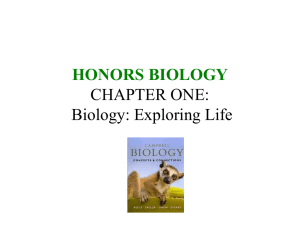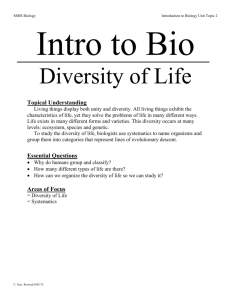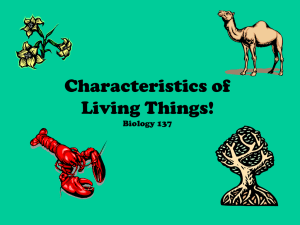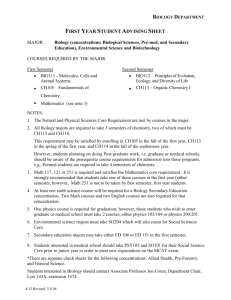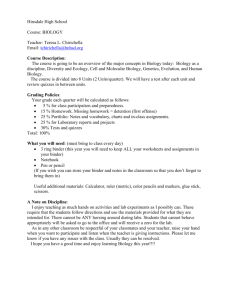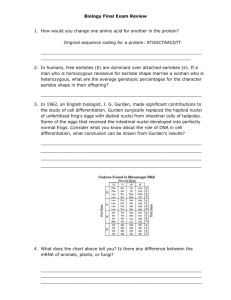1st Semester Biology Exam Written Exam You will have multiple
advertisement
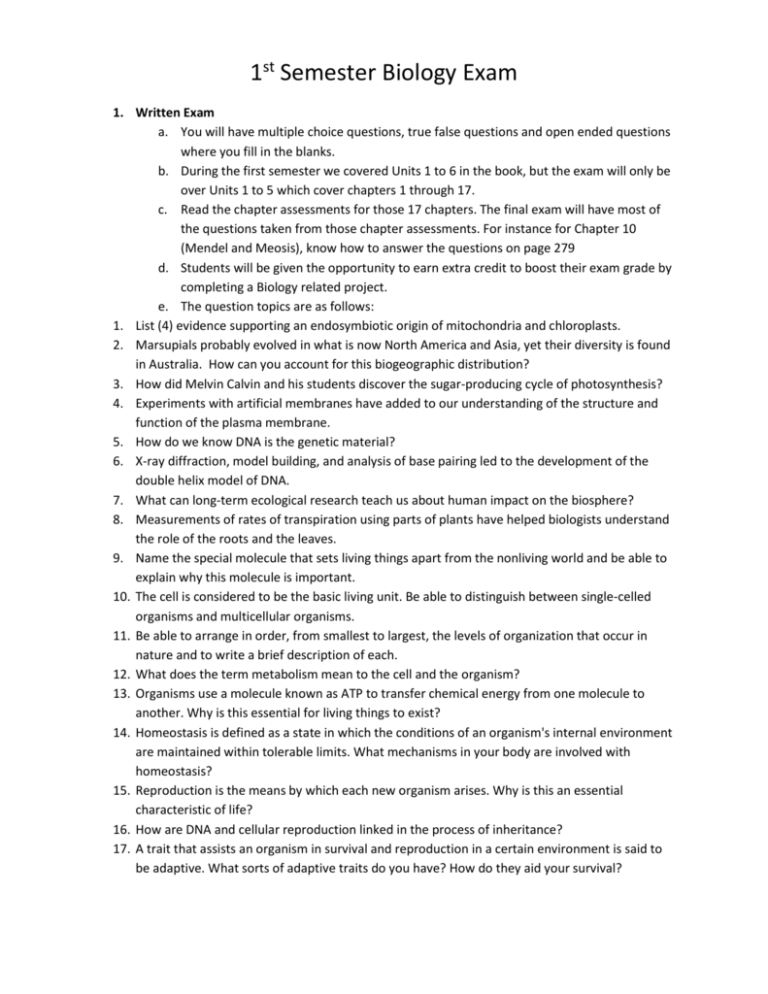
1st Semester Biology Exam 1. Written Exam a. You will have multiple choice questions, true false questions and open ended questions where you fill in the blanks. b. During the first semester we covered Units 1 to 6 in the book, but the exam will only be over Units 1 to 5 which cover chapters 1 through 17. c. Read the chapter assessments for those 17 chapters. The final exam will have most of the questions taken from those chapter assessments. For instance for Chapter 10 (Mendel and Meosis), know how to answer the questions on page 279 d. Students will be given the opportunity to earn extra credit to boost their exam grade by completing a Biology related project. e. The question topics are as follows: 1. List (4) evidence supporting an endosymbiotic origin of mitochondria and chloroplasts. 2. Marsupials probably evolved in what is now North America and Asia, yet their diversity is found in Australia. How can you account for this biogeographic distribution? 3. How did Melvin Calvin and his students discover the sugar-producing cycle of photosynthesis? 4. Experiments with artificial membranes have added to our understanding of the structure and function of the plasma membrane. 5. How do we know DNA is the genetic material? 6. X-ray diffraction, model building, and analysis of base pairing led to the development of the double helix model of DNA. 7. What can long-term ecological research teach us about human impact on the biosphere? 8. Measurements of rates of transpiration using parts of plants have helped biologists understand the role of the roots and the leaves. 9. Name the special molecule that sets living things apart from the nonliving world and be able to explain why this molecule is important. 10. The cell is considered to be the basic living unit. Be able to distinguish between single-celled organisms and multicellular organisms. 11. Be able to arrange in order, from smallest to largest, the levels of organization that occur in nature and to write a brief description of each. 12. What does the term metabolism mean to the cell and the organism? 13. Organisms use a molecule known as ATP to transfer chemical energy from one molecule to another. Why is this essential for living things to exist? 14. Homeostasis is defined as a state in which the conditions of an organism's internal environment are maintained within tolerable limits. What mechanisms in your body are involved with homeostasis? 15. Reproduction is the means by which each new organism arises. Why is this an essential characteristic of life? 16. How are DNA and cellular reproduction linked in the process of inheritance? 17. A trait that assists an organism in survival and reproduction in a certain environment is said to be adaptive. What sorts of adaptive traits do you have? How do they aid your survival? 18. List the five kingdoms of life that are currently recognized by most scientists; tell generally what kinds of organisms are classified in each kingdom, and discuss the new ideas about Domains and how they may alter the five kingdom approach. 19. Arrange in order, from the fewer to the greater numbers of organisms included, the following categories of classification: class, family, genus, kingdom, order, phylum, and species. 20. Explain what the term biological diversity means to you, and speculate about what caused the great diversity of life on Earth. 21. Define natural selection and briefly describe what is occurring when a population is said to evolve. 22. Outline a set of steps that might be used in the scientific method of investigating a problem. 23. Explain why a control group is used in an experiment. 24. Define what is meant by a theory; cite an actual example that is significant to biology. Students should insure they know all the following key vocabulary words and phrases. This is not a complete list of the vocabulary that you need to know. To make sure you have all the vocabulary you will need check the list at the beginning of each chapter (page 171 for cellular biology). Adaptation ATP (adenosine triphosphate) inheritance of acquired characteristics kingdom antibiotics Animalia asexual and sexual reproduction atmosphere binomial nomenclature biochemistry biosphere cells cell theory cardiovascular system catastrophism community conservation of matter and energy consumers cyanobacteria DNA ecosystem energy entropy Eubacteria euglenoids family food webs fossils Fungi genus heart muscle tissue heterotrophic lithosphere mitochondrion Monera multicellular multinucleate natural selection order organ organelles parasites photosynthesis phylum Plantae populations prokaryotes proteins Protista protozoa retroviruses RNA ribosome scientific method species symbioses taxonomytheory tissue unicellular uniformitarianism HIV Fungi homeostasis hydrosphere hypothesis uninucleate viruses eukaryotic producers chloroplasts 9 A 10 B Biology Prep for 1st Semester Exam 11 A 12 B 13 A Biology Practice Exam Review and Take Home Exam Biology Practice Exam 16 17 18 19 20 B A B A B Biology 1st Semester Review Biology 1st Semester Exam



